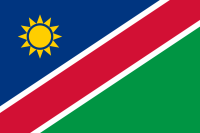 |
|
|
According to SWI method (unsolicited, long-term, foreign currency) BB[1]See Credit rating table Outlook: Negative Credit ratings from rating agencies and other models, see below. |
|
Disclaimer: Wikirating® is not a registered investment, legal or tax advisor, rating agency or a broker/dealer. All information on Wikirating® platform is intended as educational material only. All ratings and reviews published on Wikirating® are not intended to endorse or promote investment in any specific financial asset. Financial assets in general can carry a high degree of risk. Always do your own research and contact a professional. |
Comparisons
Overview of credit ratings (long-term, foreign currency) of Namibia according to the most common rating agencies (CRA) and available rating models (in alphabetical order):
| Type | Rating | Outlook | Last update | |
|---|---|---|---|---|
| DBRS Morningstar[5]No data available. | CRA | n.r. | n/a | n/a |
| Fitch Ratings[6]External Link - last update 2021-7-16 | CRA | BB | Negative | 2021-07-16 |
| Moody's Investors Service[7]Website of Moody's. Last update 2024-4-5 | CRA | B1 | Positive | 2024-04-05 |
| Scope Ratings[8]No data available. | CRA | n.r. | n/a | n/a |
| S&P Global Ratings[9]No data available. | CRA | n.r. | n/a | n/a |
| Poll (Countries)[10]See 'Rating Method Poll (Countries)' - 2018-10-15 | Model | BB- | n/a | 2012-10-30 |
| Public Sector Credit Framework (PSCF)[11]No data available. | Model | n.r. | n/a | n/a |
| Resilience (Countries)[12]Please note, that complexity values do not represent default probabilities; a 'credit rating' according to the resilience method represent the actual ability to withstand extreme events.[13]No data available. | Model | n.r. | n/a | n/a |
| Sovereign Wikirating Index (SWI)[14]SWI credit ratings are estimated for the time period 2021-2023 (based on the latest yearly evaluation from 2020-12-31). See 'Rating Method Sovereign Wikirating Index (SWI)'. | Model | BB | Negative | 2020-12-31 |
See also
References